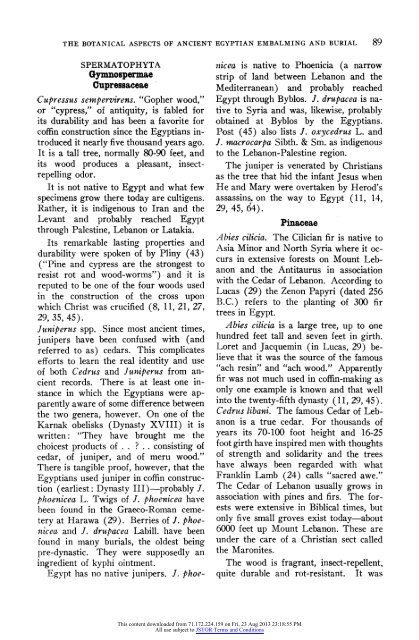The Botanical Aspects of Ancient Egyptian Embalming and Burial
The Botanical Aspects of Ancient Egyptian Embalming and Burial
The Botanical Aspects of Ancient Egyptian Embalming and Burial
Create successful ePaper yourself
Turn your PDF publications into a flip-book with our unique Google optimized e-Paper software.
THE BOTANICAL ASPECTS OF ANCIENT EGYPTIAN EMBALMING AND BURIAL 89<br />
SPERMATOPHYTA<br />
Gymnospermae<br />
Cupressaceae<br />
Cupressus sempervirens. "Gopher wood,"<br />
or '"cypress," <strong>of</strong> antiquity, is fabled for<br />
its durability ,<strong>and</strong> has been a favorite for<br />
c<strong>of</strong>fin construction since the <strong>Egyptian</strong>s introduced<br />
it nearly five thous<strong>and</strong> years ago.<br />
It is a tall tree, normally 80-90 feet, <strong>and</strong><br />
its wood produces a pleasant, insectrepelling<br />
odor.<br />
It is not native to Egypt <strong>and</strong> what few<br />
specimens grow there today are cultigens.<br />
Rather, it is indigenous to Iran <strong>and</strong> the<br />
Levant <strong>and</strong> probably reached Egypt<br />
through Palestine, Lebanon or Latakia.<br />
Its remarkable lasting properties <strong>and</strong><br />
durability were spoken <strong>of</strong> by Pliny (43)<br />
("Pine <strong>and</strong> cypress are the strongest to<br />
resist rot <strong>and</strong> wood-worms") <strong>and</strong> it is<br />
reputed to be one <strong>of</strong> the four woods used<br />
in the construction <strong>of</strong> the cross upon<br />
which Christ was crucified (8, 11, 21, 27,<br />
29, 35, 45).<br />
Juniperus spp. Since most ancient times,<br />
junipers have been confused with (<strong>and</strong><br />
referred to as) cedars. This complicates<br />
efforts to learn the real identity <strong>and</strong> use<br />
<strong>of</strong> both iCedrus <strong>and</strong> Juniperus from ancient<br />
records. <strong>The</strong>re is at least one instance<br />
in which the <strong>Egyptian</strong>s were apparently<br />
aware <strong>of</strong> some difference between<br />
the two genera, however. 'On one <strong>of</strong> the<br />
Karnak obelisks (Dynasty XVIII) it is<br />
written: "<strong>The</strong>y have brought me the<br />
choicest products <strong>of</strong> . . ? . . consisting <strong>of</strong><br />
cedar, <strong>of</strong> juniper, <strong>and</strong> <strong>of</strong> meru wood."<br />
<strong>The</strong>re is tangible pro<strong>of</strong>, however, that the<br />
<strong>Egyptian</strong>s used juniper in c<strong>of</strong>fin construction<br />
(earliest: Dynasty III)-probably J.<br />
phoenicea L. Twigs <strong>of</strong> J. phoenicea have<br />
been found in the Graeco-Roman cemetery<br />
at Harawa (29). Berries <strong>of</strong> J. phoenicea<br />
<strong>and</strong> J. drupacea Labill. have been<br />
found in many burials, the oldest being<br />
pre-dynastic. <strong>The</strong>y were supposedly an<br />
ingredient <strong>of</strong> kyphi ointment.<br />
Egypt has no native junipers. J. phoe-<br />
nticea is native to Phoenicia (a narrow<br />
strip <strong>of</strong> l<strong>and</strong> between Lebanon <strong>and</strong> the<br />
Mediterranean) <strong>and</strong> probably reached<br />
Egypt through Byblos. J. drupacea is native<br />
to Syria <strong>and</strong> was, likewise, probably<br />
obtained at Byblos by the <strong>Egyptian</strong>s.<br />
Post (45) also lists J. oxycedrus L. <strong>and</strong><br />
J. macrocarpa Sibth. & Sm. as indigenous<br />
to the Lebanon-Palestine region.<br />
<strong>The</strong> juniper is venerated by Christians<br />
as the tree that hid the infant Jesus when<br />
He <strong>and</strong> Mary were overtaken by Herod's<br />
assassins. on the way to Egypt (11, 14,<br />
29, 45, 64).<br />
Pinaceae<br />
Abies cilicia. <strong>The</strong> Cilician fir is native to<br />
Asia Minor <strong>and</strong> North Syria where it occurs<br />
in extensive forests on Mount Lebanon<br />
<strong>and</strong> the Antitaurus in association<br />
with the Cedar <strong>of</strong> Lebanon. According to<br />
Lucas (29) the Zenon Papyri (dated 256<br />
B.C.) refers to the planting <strong>of</strong> 300 fir<br />
trees in Egypt.<br />
A bies cilicia is a large tree, up to one<br />
hundred feet tall <strong>and</strong> seven feet in girth.<br />
Loret <strong>and</strong> Jacquemin (in Lucas, 29) believe<br />
that it was the source <strong>of</strong> the famous<br />
"ach resin" <strong>and</strong> "ach wood." Apparently<br />
fir was not much used in c<strong>of</strong>fin-making as<br />
only one example is known <strong>and</strong> that well<br />
into the twenty-fifth dynasty ( 11, 29, 45).<br />
Cedrus libani. <strong>The</strong> famous Cedar <strong>of</strong> Lebanon<br />
is a true cedar. For thous<strong>and</strong>s <strong>of</strong><br />
years its 70-100 foot height <strong>and</strong> 16-25<br />
foot girth have inspired men with thoughts<br />
<strong>of</strong> strength <strong>and</strong> solidarity <strong>and</strong> the trees<br />
have always been regarded with what<br />
Franklin Lamb (24) calls "sacred awe."<br />
<strong>The</strong> Cedar <strong>of</strong> Lebanon usually grows in<br />
association with pines <strong>and</strong> firs. <strong>The</strong> forests<br />
were extensive in Biblical times, but<br />
only five small groves exist today-about<br />
6000 feet up Mount Lebanon. <strong>The</strong>se are<br />
under the care <strong>of</strong> a Christian sect called<br />
the Maronites.<br />
<strong>The</strong> wood is fragrant, insect-repellent,<br />
quite durable <strong>and</strong> rot-resistant. It was<br />
This content downloaded from 71.172.224.159 on Fri, 23 Aug 2013 23:18:55 PM<br />
All use subject to JSTOR Terms <strong>and</strong> Conditions
















